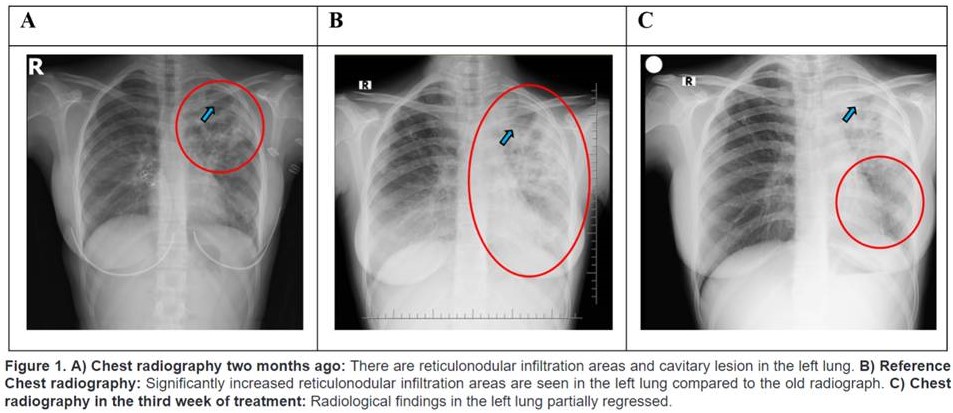A Case Of Pulmonary Tuberculosis Detected While Being Investigated With A Preliminary Diagnosis Of Covid-19 Infection
Covid-19 Infection and Pulmonary Tuberculosis
Abstract
A 15-year-old female patient, who had no previous history of illness, had the complaint of intermittent cough and chest pain for 2 months. Two days ago, she applied to the hospital with difficulty in breathing added to her complaints. Tomography (CT) was planned due to the presence of pneumonic infiltration in the left lung (Figure 1) in the chest radiography of the patient who was hospitalized in the intensive care unit due to respiratory distress. The patient was referred to us after Covid-19 was considered. On physical examination, there was bilateral diffuse ral in the lung with auscultation and respiratory sounds were decreased in the left lung. Its oksigen saturation was determined as 89% on room air, RR:28/min. Pathologically in laboratory evaluation; Erythrocyte Sedimentation Rate:56 mm/hour, C-reactive protein:8 mg/dl. The patient was admitted to the pandemic service with the pre-diagnosis of Covid-19 infection and Pneumonia. There was a history of smoking 1 pack per day for 2-3 years. The pneumonia treatment of the patient was arranged as Ceftriaxone and Azithromycin. Covid-19 PCR Tests taken resulted as Negative. In thoracic CT imaging, it was evaluated as significant by the radiology in terms of tuberculosis (TB)(Figure 2). The PPD of the patient was evaluated as negative with 3 mm (BCG single scar). There was no known history of tuberculosis contact in the family history. With the diagnosis of "Pulmonary Tuberculosis" with the diagnosis of sputum ARB (++), antituberculosis treatment consisting of Isoniazid, Rifampicin, Pyrazinamide and Ethambutol was initiated due to cavity-widespread pulmonary TB. The patient, whose need for oxygen decreased during follow-up, was discharged on the 10th day of his treatment, with outpatient follow-up planned.
In some individuals, tuberculosis bacillus reacts and multiplies, causing the development of post-primary TB. Although the post-primary TB radiological findings may overlap with the findings of primary TB, it has some distinctive findings such as preferring the upper lobes, not following lymphadenopathy, and a tendency to create cavitation (1). Tomography provides important contributions in the detection of parenchymal pathology and lymphadenopathies in patients who are evaluated with the pre-diagnosis of tuberculosis, or in patients with suspected tuberculosis clinically but without radiographic findings (2). In this period when Covid-19 infection is common, tuberculosis should be kept in mind in patients with long-term cough.









